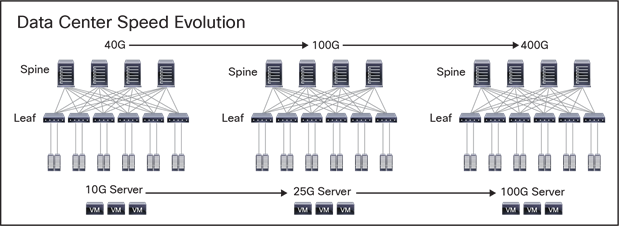Migrate Data Center Networks to 100G and 400G over Multimode Fiber
Available Languages
Bias-Free Language
The documentation set for this product strives to use bias-free language. For the purposes of this documentation set, bias-free is defined as language that does not imply discrimination based on age, disability, gender, racial identity, ethnic identity, sexual orientation, socioeconomic status, and intersectionality. Exceptions may be present in the documentation due to language that is hardcoded in the user interfaces of the product software, language used based on RFP documentation, or language that is used by a referenced third-party product. Learn more about how Cisco is using Inclusive Language.
Data center networks must evolve on two fronts. First and foremost, they need to support the growing bandwidth and traffic requirements of distributed, data-intensive applications—like IoT, artificial intelligence, machine learning, and more—that are already straining today’s 10G and 40G links. And second, they need to be more power efficient to address the rising demand for sustainability.
Upgrading data center networks with 400G optical transceivers addresses both needs. And it can be done without any changes to existing multimode fiber, which provides cost-effective support for higher speeds across shorter distances in switch-to-switch and switch-to-server configurations.
Cisco QSFP 100G SR1.2 optical transceivers enable the transition to 100G using existing bidirectional duplex fiber. Cisco QSFP-DD 400G SR4.2 optical transceivers enable the transition to 400G using either bidirectional duplex or SR4 quad fiber. And both ease the migration to higher speeds, preserve fiber infrastructure and investments, and deliver improved power efficiency and sustainability.
Benefits of Cisco QSFP 100G SR1.2 and QSFP-DD 400G SR4.2
● Stay ahead of growing traffic demands with multiple paths to 400G.
● Preserve existing investments in multimode fiber infrastructure.
● Leverage breakout capabilities and high-density links to connect 400G and 100G ports.
● Benefit from the latest high-speed platforms and capabilities.
● Improve data center network power efficiency and sustainability.

Data center speed evolution to 400G
Migrate using bidirectional duplex fiber
Cisco QSFP 100G SR1.2 and Cisco QSFP-DD 400G SR4.2 optical transceivers can utilize existing bidirectional duplex fiber as data center teams migrate their networks to higher speeds. And because they are interoperable, they allow an incremental migration from 100G to 400G. In addition, Cisco QSFP-DD SR4.2 transceivers support breakout connectivity to Cisco QSFP 100G SR1.2. This enables data center teams to upgrade one end of their links to 400G ports while providing high-density links to 100G ports on the other end.
Migrate using SR4 quad fiber
In addition to bidirectional duplex fiber, Cisco QSFP-DD 400G SR4.2 optical transceivers can also utilize existing SR4 quad fiber. This allows data center teams to deliver 400G connectivity in the network spine or across spine and leaf architectures while preserving their SR4 fiber investments and infrastructure.
Improve data center sustainability with 400G
Migrating to 400G doesn’t just supercharge network bandwidth and performance—it also improves data center efficiency and sustainability. New 400G platforms leveraging 112G SerDes technology and Cisco Silicon One, provide exceptional density, reduced power consumption per bit, and improved optical power efficiencies, yielding improved power and cooling efficiency within the data center.
Find detailed product information about Cisco QSFP-DD 400G SR4.2 and Cisco QSFP 100G SR1.2 optical modules. To learn more about Cisco optical transceivers, visit Cisco Optics.